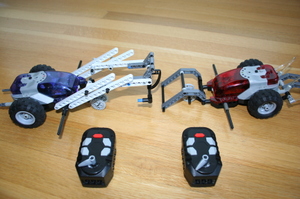
 One of my many failures as a geek dad has been my inability to get the kids interested in robotics, which is my own passion. The simple educational robots (little single-function machines) I’ve brought home are too boring, and real programmable robots are too complicated. But this weekend we had a breakthrough, when the seven-year-old happened to dig up some old Lego Spybotics bots we had in a closet.
One of my many failures as a geek dad has been my inability to get the kids interested in robotics, which is my own passion. The simple educational robots (little single-function machines) I’ve brought home are too boring, and real programmable robots are too complicated. But this weekend we had a breakthrough, when the seven-year-old happened to dig up some old Lego Spybotics bots we had in a closet.
You may remember Spybotics as the failed robotics product line Lego launched in the long gap between Mindstorms RCX and Mindstorms NXT (the dark ages of Lego robotics, from about 2000 to late 2006). They were programmable vehicles with motors and touch and IR sensors, along with IR transmitter "lasers". You were supposed to use a CD-Rom program to give them "missions" or to program them to battle. But they were very limited, the software was clunky, and they didn’t sell.
As it happened the Spybotics also came with an IR remote control to drive them manually, and it was that the kids remembered. When we got them out, it was clear that Spybotics had been tragically mismarketed. They should have been sold as "Lego Battlebots", with hardware customization
(weapons, shields, etc) and remote-control battles as the primary function, with programmability a secondary function for kids who wanted a greater challenge.
The picture above shows the results of a day of happy playing between an 11-year-old and the 7-year-old. They started with basic Spybots (one had treads, the other wheels) and eventually experimented with dozens of different shapes, propulsion, weapons, defenses and nifty Lego assemblies to exploit weaknesses in their opponent. For instance, when they finished tonight, the Spybot on the left had a nifty hook that can grab bits of the opponent and rip them off, while the bot on the right had wedge scoops on front and back to flip the opponent.
They came up with three competition modes:
- Free battle: First to flip, or win by points (pieces ripped from your enemy)
- Obstacle course: start from opposite sides of the course. First to finish wins, and a collision in the middle is part of the game.
- Sumo battle. First to push the other out of a ring, wins the round. Play to ten rounds.
Although there was no programming involved, there was a lot of mechanical engineering and thinking about what makes one machine better than another. That’s just like BattleBots, which are, after all, remote control (not autonomous), too. Someday my kids will be ready for programming and "real" robotics, but for now I’m just delighted by how much fun they had with simply building their own killer machines and then testing them in battle on the spot, with the fastest build-test-learn cycle you can imagine.
You can still find Spybotics on eBay.
